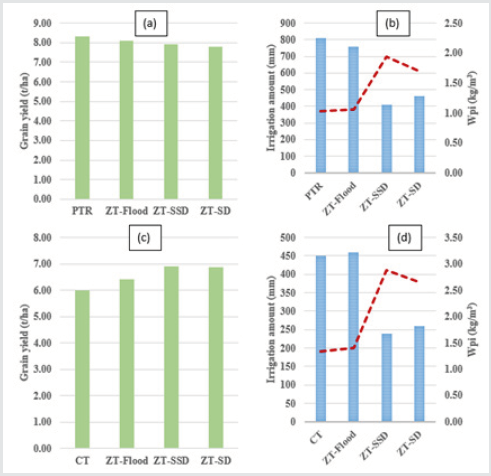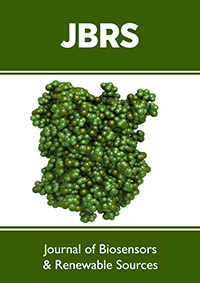
Lupine Publishers Group
Lupine Publishers
Menu
Mini ReviewOpen Access 
Soil-Sensors for Real Time Irrigation to Match Crop Water Requirement in Subsurface Drip System Volume 1 - Issue 1
Ravneet Kaur Sidhu1 and Sidhu HS2*
- 1Research Scholar, Thapar University, India
- 2Principle Scientist, Borlaug Institute for South Asia, India
Received: November 08, 2019 Published: November 13, 2019
Corresponding author: Sidhu HS, Principle Scientist, Borlaug Institute for South Asia, Ludhiana, India
DOI: 10.32474/JBRS.2019.01.000104
Introduction
Globally, water availability is becoming progressively scarce and by 2025 more than one-third of the world population would face severe water shortage [1,2]. The arid and semi-arid regions of Asia, the Middle-East, and sub-Saharan Africa, which are having a high concentration of the world’s population with a large section living below the poverty line, will be the worst affected areas. While demand for food and other agricultural commodities in these areas is increasing due to fast-growing population, freshwater availability is continuously declining. Per capita availability of renewable freshwater in Near East and North Africa is less than 10 percent of the world average [3]. Agriculture is a major consumer of water for irrigation and accounts for about 70% of freshwater use in India. There is an increasing need for re-allocation of water used for irrigation due to its increasing demand from domestic and industrial sectors but this may seriously impair the availability of food and fiber across the globe. As a consequence of increasing water scarcity and drought, resulting from climate change, considerable water use for irrigation is expected to occur in the context of tough competition between agribusiness and other sectors of the economy. The reduction in the availability of water for irrigation may result in lowering the productivity of irrigated crops, especially rice which consumes about120–180 cm of water [4,5]. Flood irrigation (surface irrigation) is the most common method of irrigation in developing countries but it is very inefficient because only 50% of the applied water is actually used by the crop. If water use efficiency does not improve, the arid and semi-arid regions of the world could suffer under water scarcity in the next 1 to 2 decades.
Optimization of irrigation water use in time and space requires scientific scheduling of its application to conserve water and optimize crop yield. Irrigation scheduling is a systematic process to estimate the Irrigation Water (IW) requirement to avoid water stress in the crop over relatively short periods. Crop water requirement is estimated using different parameters viz. crop Evapotranspiration (ET), plant observation, measurement of canopy temperature, soil moisture monitoring, etc. and is sufficient to meet all crop water needs during this short interval between two successive irrigations. Irrigation scheduling based on soil moisture includes assessment of soil moisture status (volumetric soil water content or matric potential) within the root zone and knowledge about the wilting point for the crop. Initially, the moisture level is raised up-to field capacity and as water is consumed by the crop, it is applied to the crop as per requirement. Based on volumetric soil moisture content, the irrigation threshold is generally expressed as percentage depletion of total available water (the amount of water held in the soil between field capacity and permanent wilting point) in the root zone. Several techniques used for determining volumetric soil water content can be neutron attenuation, Time-Domain Reflectometry (TDR), and capacitance [6]. Alternatively, irrigation can be scheduled based on Soil Matric Potential (SMP), at an explicit depth in the soil profile.
The tensiometers and granular matrix sensors are most commonly used for determining SMP and these can be logged or manually read. The tube tensiometers are easy to use, robust and relatively inexpensive devices. These consist of a plastic tube connected to a porous ceramic cup on one end and a vacuum gauge on the other. Tensiometer indicates in situ soil moisture in real-time and it precisely measures SMP in the moisture range from 0 to about -80 kPa, and thus covers the moisture range required for the major crops. The threshold value of SMP for scheduling irrigation depends on the type of crop to be grown. Based on this criterion [7] recommended that Puddled Transplanted Rice (PTR) should be irrigated at an SMP of −16 kPa measured at a soil depth of 20 cm depth. For scheduling irrigation under different tillage and mulch treatments, [8] recommended an SMP -35 kPa at a soil depth of 32.5 cm for wheat and -15 kPa at 17.5 cm soil depth for Dry Seeded Rice (DSR). With the decrease in the market price of basic soil moisture sensors, small and medium-size farmers can use these devices to monitor soil moisture content. Such instruments provide location-specific data and are quite accurate and can be used in conjunction with other techniques to arrive at the appropriate irrigation schedules for crops. The most commonly used devices for measuring soil moisture are Electrical Resistance Sensing Devices (ERSDs) and tensiometers. Both should be installed directly in the wetted soil in the root zone of the crop at 2-3 locations in the field for reliable and accurate monitoring. These are often installed at different depths in pairs, e.g., at a depth of 15 and 30 cm, to provide information regarding moisture availability in the root zone. Soil moisture sensors provide data regarding SMP which can be used to develop irrigation schedules for maintaining soil moisture at appropriate levels conducive for optimal growth at different stages of crop development. Some crops grow better in slightly waterstressed conditions (e.g. cotton) in their initial growth period and some do not require irrigation (e.g., potatoes) once the plants start dying back. Others, especially DSR and small-seeded crops (e.g. vegetables) need just moist soils for effective germination. In deciding an appropriate irrigation application time and rate, the farmers must consider some additional factors viz. weather, stage of crop growth, weed and pest control operations and timing of harvest. Flood irrigation method popular in developing countries is generally manually operated but some semi-automated and automated systems are being deployed now to improve irrigation efficiency in the field. To provide the uniform and precise quantity of IW in the prevailing scenario of water and labour shortages, the sensor-based automated system will be more appropriate. Real- Time sensing and communication can help to improve irrigation response time. Low-cost wireless sensors can be deployed in the form of a mesh network for efficient and robust communication [9]. Wireless communication can play a key role in managing and monitoring agricultural operations on the farm. In irrigation, it provides an opportunity for automatic activation of the system when soil moisture and temperature touch the threshold limit. Presently, sensors are available which can sense the depth of water especially in puddled transplanted rice and can help in saving water.
A sensor (Automatic IRROMETER tensiometer with magnetic switch which is capable of having switching capability at the desired SMP) attached to tensiometer sends the signal to the electric operated tubewell whenever SMP reaches below a predetermined critical level ( e.g. -15 kPa in rice and -35 kPa in wheat) was developed at Borlaug Institute for South Asia (BISA) Ladhowal, Punjab, India. This automated sensor was evaluated for both Surface Drip (SD) and Subsurface Drip (SSD) irrigation systems in comparison to flood irrigation for both Conventional Till (CT) and Zero-Till (ZT) conditions in both rice and wheat. The grain yield of rice was statistically similar (p=0.05) in the four management scenarios (Figure 1a). Using SD and SSD irrigation systems, rice needed 30- 40 cm less irrigation water compared with conventional PTR and flood irrigated ZT DSR Figure 1B. The irrigation water productivity was significantly higher by 88.5, 81.4 and 14.3 percent under SSD compared to PTR, ZTDSR flood, and SD treatments, respectively (Figure 1b). Grain yield of wheat was 15% higher under sensorbased ZT-SSD as compared to the CT flood (5.99 t/ha) treatment (Figure 1c). Using SD and SSD irrigation systems, wheat needed 190-220 mm less irrigation water compared with conventional CT and ZT-flood irrigated wheat (Figure 1d). The irrigation water productivity was higher by 2.17 and 2.07 times under sensor based SSD compared to CT and ZT flood treatments, respectively (Figure 1d). Similarly, our study suggested that MPS6 sensors could be also used in an automated irrigation system for both rice and wheat under SSDF and flood conditions. In view of above, it is felt that irrigation water productivity with sensor based subsurface drip will be markedly better than the other known methods of irrigation. This will help ensure better food security for the future generations in the face of declining freshwater availability for agriculture. However, to judiciously utilise the available water for irrigation, use of other climatic and plant-based sensors may also be explored in future.
Figure 1: Flow-chart of the terms used and number of published articles for each one and replace with Effect of four management scenarios on (a) rice grain yield; (b) irrigation amount and water productivity in rice; (c) wheat grain yield; and (d) irrigation amount and water productivity in wheat under automation in rice and wheat at BISA farm.

References
- Seckler D, Amarasinghe U, Molden D, de Silva R, Barker R (1998) World Water and Demand and Supply, 1990 to 2025: Scenarios and Issues. International Water Management Institute, Colombo.
- Rosegrant M, Cai X, Cline S (2002) World Water and Food to 2025. Dealing with Scarcity. International Food Policy Research Institute, Washington, USA.
- FAO (2017) Near East and North Africa Regional Overview of Food Insecurity: Sustainable Agriculture Water Management is Key to Ending Hunger and to Climate Change Adaptation. Cairo, pp. 35.
- Bindraban PS, Hengsdijk H, Cao W, Shi Q, Thiyagarajan TM, et al. (2006) Transforming inundated rice cultivation. Int J Water Res Dev 22(1): 87-100.
- Chauhan BS, Mahajan G, Sardana V, Timsina J, Jat ML (2012) Productivity and sustainability of the rice-wheat cropping system in the Indo-Gangetic Plains of the Indian subcontinent: Problems, opportunities, and strategies. Adv Agron 117: 315-369.
- Charlesworth P (2005) Soil water monitoring. Irrigation insights No. 1, 2nd Edition. Land and Water, Australia.
- Kukal SS, Hira GS and Sidhu AS (2005) Soil matric potential-based irrigation scheduling to rice (Oryza sativa). Irrig Sci 23(1): 153-159.
- Gupta N, Yadav S, Humphreys E, Kukal SS, Singh B, Eberbach PL (2016) Effects of tillage and mulch on the growth, yield and irrigation water productivity of a dry seeded rice-wheat cropping system in north-west India. Field Crops Res 196: 219-236.
- Akyildiz IF and Wang X (2005) A survey on wireless mesh networks. IEEE Communications Magazine 43: 23-30.
- Sidhu HS, Jat ML, Yadvinder-Singh, Sidhu RK, Gupta N, et al. (2019) Sub-surface drip fertigation with conservation agriculture in a rice-wheat system: A breakthrough for addressing water and nitrogen use efficiency. Agri Water Mgmt 216: 273-283.

Top Editors
-

Mark E Smith
Bio chemistry
University of Texas Medical Branch, USA -

Lawrence A Presley
Department of Criminal Justice
Liberty University, USA -

Thomas W Miller
Department of Psychiatry
University of Kentucky, USA -

Gjumrakch Aliev
Department of Medicine
Gally International Biomedical Research & Consulting LLC, USA -

Christopher Bryant
Department of Urbanisation and Agricultural
Montreal university, USA -

Robert William Frare
Oral & Maxillofacial Pathology
New York University, USA -

Rudolph Modesto Navari
Gastroenterology and Hepatology
University of Alabama, UK -

Andrew Hague
Department of Medicine
Universities of Bradford, UK -

George Gregory Buttigieg
Maltese College of Obstetrics and Gynaecology, Europe -

Chen-Hsiung Yeh
Oncology
Circulogene Theranostics, England -
.png)
Emilio Bucio-Carrillo
Radiation Chemistry
National University of Mexico, USA -
.jpg)
Casey J Grenier
Analytical Chemistry
Wentworth Institute of Technology, USA -
Hany Atalah
Minimally Invasive Surgery
Mercer University school of Medicine, USA -

Abu-Hussein Muhamad
Pediatric Dentistry
University of Athens , Greece

The annual scholar awards from Lupine Publishers honor a selected number Read More...



